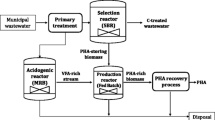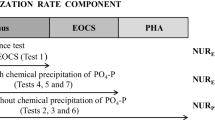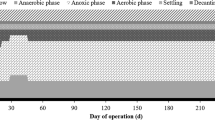Abstract
A strategy was evaluated for conditioning activated sludge biomass to a new substrate whereby the polyhydroxyalkanoate (PHA) accumulation capacity of the biomass was enhanced based on a series of aerobic feast–famine acclimation cycles applied prior to PHA accumulation. Different biomass types enriched during the treatment of municipal wastewater at laboratory, pilot, and full scales were exposed to aerobic feast–famine acclimation cycles at different feast-to-famine ratios with an acetate–propionate mixture (laboratory scale), acetate (pilot scale), and fermented waste–sludge centrate (pilot scale). A sevenfold increase in specific PHA storage rates and 20% increase in substrate utilization rates were observed during acclimation cycles (laboratory acetate–propionate). Biomass acclimation led to more than doubling of the specific substrate utilization rates, PHA storage rates, biomass PHA contents, and specific PHA productivities (per initial biomass) during PHA accumulation. The biomass PHA contents were found to increase due to acclimation from 0.19 to 0.34 (laboratory acetate–propionate), 0.39 to 0.46 (pilot acetate) and 0.19 to 0.25 gPHA/gVSS (pilot centrate). A similar bacterial community structure during acclimation indicated that a physiological rather than a genotypic adaptation occurred in the biomass. The physiological state of the biomass at the start of PHA accumulation was deemed significant in the subsequent PHA-accumulation performance. Positive acclimation trends can be monitored by measuring the relative increase in feast substrate utilization or respiration rates with respect to those of the first acclimation cycle.






Similar content being viewed by others
References
Kleerebezem, R., Joosse, B., Rozendal, R., Van Loosdrecht, M.C.M.: Anaerobic digestion without biogas? Rev. Environ. Sci. Biotechnol. 14(4), 787–801 (2015)
Tyagi, V.K., Lo, S.L.. Sludge: A waste or renewable source for energy and resources recovery? Renew. Sustain. Energy Rev. 25(71), 708–728 (2013). doi:10.1016/j.rser.2013.05.029
Arcos-Hernández, M., Montaño-Herrera, L., Murugan Janarthanan, O., Quadri, L., Anterrieu, S., Hjort, M., et al.: Value-added bioplastics from services of wastewater treatment. Water Pract. Technol. 10(3):546–555 (2015). http://www.iwaponline.com/wpt/010/wpt0100546.htm
Laycock, B., Halley, P., Pratt, S., Werker, A., Lant, P.: The chemomechanical properties of microbial polyhydroxyalkanoates. Prog. Polym. Sci. 38(3–4), 536–583 (2013). http://linkinghub.elsevier.com/retrieve/pii/S007967001200072X
Koller, M., Maršálek, L., de Sousa Dias, M.M., Braunegg, G.: Producing microbial polyhydroxyalkanoate (PHA) biopolyesters in a sustainable manner. New Biotechnol. 37, 24–38 (2017)
Werker, A.G., Johansson, P.S.T., Magnusson, P.O.G.: Process for the extraction of polyhydroxyalkanoates from biomass. WO. 2014/125422, A1 (2014)
Valentino, F., Morgan-Sagastume, F., Campanari, S., Villano, M., Werker, A., Majone, M.: Carbon recovery from wastewater through bioconversion into biodegradable polymers. New Biotechnol. 37, 9–23 (2017). doi:10.1016/j.nbt.2016.05.007
Morgan-Sagastume, F., Valentino, F., Hjort, M., Cirne, D., Karabegovic, L., Gerardin, F., et al.: Polyhydroxyalkanoate (PHA) production from sludge and municipal wastewater treatment. Water Sci. Technol. 69(1), 177–184 (2014)
Valentino, F., Morgan-Sagastume, F., Fraraccio, S., Corsi, G., Zanaroli, G., Werker, A., et al.: Sludge minimization in municipal wastewater treatment by polyhydroxyalkanoate (PHA) production. Environ. Sci. Pollut. Res. Int. 20, 7281–7294 (2015). http://www.ncbi.nlm.nih.gov/pubmed/24996948
Bengtsson, S., Karlsson, A., Alexandersson, T., Quadri, L., Hjort, M., Johansson, P., et al.: A process for polyhydroxyalkanoate (PHA) production from municipal wastewater treatment with biological carbon and nitrogen removal demonstrated at pilot-scale. New Biotechnol. 35, 42–53 (2017). http://linkinghub.elsevier.com/retrieve/pii/S1871678416324268
Morgan-Sagastume, F., Heimersson, S., Laera, G., Werker, A., Svanström, M.: Techno-environmental assessment of integrating polyhydroxyalkanoate (PHA) production with services of municipal wastewater treatment. J. Clean Prod. 137, 1368–1381 (2016). http://linkinghub.elsevier.com/retrieve/pii/S0959652616311337
Morgan-Sagastume, F., Hjort, M., Cirne, D., Gerardin, F., Lacroix, S., Gaval, G., et al.: Integrated production of polyhydroxyalkanoates (PHAs) with municipal wastewater and sludge treatment at pilot scale. Bioresour. Technol. 181, 78–89 (2015). doi:10.1016/j.biortech.2015.01.046
Bengtsson, S., Werker, A., Visser, C., Korving, L.: PHARIO—Stepping stone to a sustainable value chain for PHA bioplastic using municipal activated sludge. Amersfoort (2017)
Majone, M., Dircks, K., Beun, J.: Aerobic storage under dynamic conditions in activated sludge processes. The state of the art. Water Sci. Technol. 39(1):61–73 (1999). http://www.sciencedirect.com/science/article/pii/S0273122398007768
Van Loosdrecht, M.C.M., Pot, M.A., Heijnen, J.J.: Importance of bacterial storage polymers in bioprocesses. Water Sci. Technol. 35(1), 41–47 (1997). doi:10.1016/S0273-1223(96)00877-3
Morgan-Sagastume, F.: Characterisation of open, mixed microbial cultures for polyhydroxyalkanoate (PHA) production. Rev. Environ. Sci. Biotechnol. 15(4), 1–33 (2016)
Dionisi, D., Majone, M., Vallini, G., Gregorio, S.D., Beccari, M.: Effect of the length of the cycle on biodegradable polymer production and microbial community selection in a sequencing. Batch Reactor. 23, 1064–1073 (2007)
Janarthanan, O.M., Laycock, B., Montano-Herrera, L., Lu, Y., Arcos-Hernandez, M. V., Werker, A., et al.: Fluxes in PHA-storing microbial communities during enrichment and biopolymer accumulation processes. New Biotechnol. 33(1), 61–72 (2016). doi:10.1016/j.nbt.2015.07.007
Werker, A.G., Bengtsson, S.O.H., Hjort, J.M., Morgan-Sagastume, F., Majone, M., Valentino, F.: Process for enhancing polyhydroxyalkanoate accumulation in activated sludge biomass. WO 2016/020884 A1, (2016)
Valentino, F., Brusca, A.A., Beccari, M., Nuzzo, A., Zanaroli, G., Majone, M.: Start up of biological sequencing batch reactor (SBR) and short-term biomass acclimation for polyhydroxyalkanoates production. J. Chem. Technol. Biotechnol. 88(2), 261–270 (2013). http://doi.wiley.com/10.1002/jctb.3824
Valentino, F., Beccari, M., Fraraccio, S., Zanaroli, G., Majone, M.: Feed frequency in a Sequencing Batch Reactor strongly affects the production of polyhydroxyalkanoates (PHAs) from volatile fatty acids. New Biotechnol. 31(4), 264–275 (2014). doi:10.1016/j.nbt.2013.10.006
Werker, A.G., Bengtsson, S.O.H., Karlsson, C.A.B.: Method for accumulation of polyhydroxyalkanoates in biomass with on-line monitoring for feed rate control and process termination. International Publication Number WO 2011/070544 A2, 16.06.2011., (2011)
Braunegg, G., Sonnleitner, B., Lafferty, R.M.: A rapid gas chromatographic method for the determination of poly-ßhydroxybutyric acid in microbial biomass. Eur. J. Appl. Microbiol. Biotechnol. 6, 29–37 (1978)
Werker, A.G., Johansson, P.S.T., Magnusson, P.O.G., Maurer, F.H.J., Jannasch, P.: Method for recovery of stabilized polyhydroxyalkanoates from biomass that has been usedto treat organic waste. WO 2012/022998 A1, (2012)
Zanaroli, G., Di Toro, S., Todaro, D., Varese, G.C., Bertolotto, A., Fava, F.: Characterization of two diesel fuel degrading microbial consortia enriched from a non acclimated, complex source of microorganisms. Microb Cell Fact. 9, 10 (2010)
Gujer, W., Henze, M.: Activated sludge modeling and simulation. Water. Sci. Technol. 23, 1011–1023 (1991)
Valentino, F., Karabegovic, L., Majone, M., Morgan-Sagastume, F., Werker, A.: Polyhydroxyalkanoate (PHA) storage within a mixed-culture biomass with simultaneous growth as a function of accumulation substrate nitrogen and phosphorus levels. Water Res. 77, 49–63 (2015). doi:10.1016/j.watres.2015.03.016
Chen, W.-M., Lin, Y.-S., Sheu, D.-S., Sheu, S.-Y.: Delftia litopenaei sp. nov., a poly-β-hydroxybutyrate-accumulating bacterium isolated from a freshwater shrimp culture pond. Int. J. Syst. 62(Pt 10), 2315–2321 (2012). http://www.ncbi.nlm.nih.gov/pubmed/22140156
Volova, T.G., Prudnikova, S.V., Boyandin, A.N.: Biodegradable poly-3-hydroxybutyrate as a fertiliser carrier. J. Sci. Food Agric. 95, 4183–4193 (2016)
Nikodinovic-Runic, J., Guzik, M., Kenny, S.T., Babu, R., Werker, A., O’Connor, K.E.: Carbon-rich wastes as feedstocks for biodegradable polymer (polyhydroxyalkanoate) production using bacteria. Adv. Appl. Microbiol. 84, 139–200 (2013). doi:10.1016/B978-0-12-407673-0.00004-7
Acknowledgements
This work was partially funded by the EU ROUTES project (Contract No. 265156, FP7 2007–2013, THEME [ENV.2010.3.1.1-2] Innovative system solutions for municipal sludge treatment and management).
Author information
Authors and Affiliations
Corresponding author
Rights and permissions
About this article
Cite this article
Morgan-Sagastume, F., Valentino, F., Hjort, M. et al. Acclimation Process for Enhancing Polyhydroxyalkanoate Accumulation in Activated-Sludge Biomass. Waste Biomass Valor 10, 1065–1082 (2019). https://doi.org/10.1007/s12649-017-0122-8
Received:
Accepted:
Published:
Issue Date:
DOI: https://doi.org/10.1007/s12649-017-0122-8




